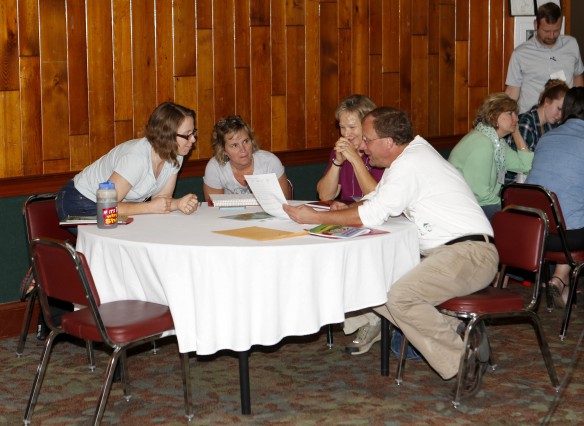
Amanda Heltzel, second from right, a science lab teacher at Julius Marks Elementary School (Fayette County), participates in an exercise with Sarah Talley of the USDA Forest Service, Barb Cornett of the Life Adventure Center/Buckley Wildlife Sanctuary and David Lawler of Maysville Community and Technical College during a discussion on flipped classrooms at the Kentucky Association for Environmental Education Conference at Jenny Wiley State Resort Park.
Photo by Mike Marsee, Sept. 11, 2015
By Mike Marsee
michael.marsee@education.ky.gov
LeAnna Pritchard isn’t ready to completely turn her classroom upside down, but she can see the value in a flipped classroom.
Pritchard, a teacher at Wingo Elementary School (Graves County), came to the Kentucky Association for Environmental Education’s annual conference in early September in search of ideas. She found one that intrigued her in a discussion on flipped, topics-based science classes and how they can encourage active learning.
“I’m an educator and I’m a lifelong learner. Even though this is my 24th year to teach, I still want to learn so I can go back and help my students learn,” said Pritchard, who also helped present a workshop on quilting art at the conference at Jenny Wiley State Resort Park in Prestonsburg.
Flipping the classroom can allow students to use more technology in and out of the classroom and increase class time for discussions and activities.
“The lecture-based work is done at home and what we consider homework is done in the classroom,” said presenter Justin Weiss, an assistant professor of biology at Maysville Community and Technical College. He was the presenter at the workshop and demonstrated how to flip a conservation biology course.
It’s not a new concept, but it is still gaining traction. Weiss said reasons to flip a classroom include:
- It can make it easier to teach students with shorter attention spans.
- Students can set their own pace.
- It can lead to more active and less passive learning.
- The learning can be more in-depth.
- Classroom assignments reinforce lectures students learn at home.
“I’m always looking for ways to actively engage my students and create more hands-on learning, so I wanted to see what ideas he had,” said Amanda Heltzel, a science lab teacher at Julius Marks Elementary School (Fayette County). “I really liked them talking about different ways of teaching, different learning styles, how to make sure our students are engaged. This was a little bit different for me, because I’m a science lab teacher and I don’t give homework or home assignments, but it was a good way to get people actively engaged during the class.”
Pritchard said her third-grade students would be interested in the activities, though she said the homework she and her colleagues give students might not be sufficient for a truly flipped classroom.
Pritchard said that while it might be difficult for her to ask primary school students and their parents to commit to the high quantity of at-home study required in a truly flipped classroom, she could envision a kind of flipped classroom within her class time at school.
“It would probably be more applicable for me to have a balance of lectures and activities within the classroom, rather than put the weight of it on the parents,” she said.
Elements of the flipped classroom could be useful, said Pritchard, as Graves County implements the nontraditional school days program – also known as cyber snow days – this winter.
“We’re starting to have sessions or classrooms prepared so that if we do have a snow issue, they can do things at home. We are thinking about more Internet-type classes and lessons,” she said.
Both Pritchard and Heltzel said while the flipped classroom works well for science classes, it could serve other subject areas equally well.
“I could easily see it working in social studies or history, reading about the basics or discovering the basics on your own and then bringing that into the classroom in different, realistic concepts,” Heltzel said.
There were plenty of other concepts that also were attractive to educators at the conference, which focused on STEAM subjects – science, technology, engineering, arts and agriculture and mathematics – and on innovative ways of making learning through the environment relevant to adults, teachers and students.
Topics ranged from climate change and oceanography to making jams and jellies and focusing on environmental education opportunities within the Next Generation Science Standards.
Lea Shewmaker, a STEM lab teacher at Bloomfield Elementary School (Nelson County) who attended the conference for the first time, said she was drawn by the number of things she saw on the agenda that she might be able to use in her classroom.
“It’s a chance to be more informed and to get ideas I can share with my students,” she said.
Shewmaker was looking for something different from Robin Magruder’s session on an active elementary STEM unit in which the Campbellsville University professor of education described a lesson on energy transfer and transformation that integrates technology.
The demonstration included a kind of relay demonstrating how energy is transferred to plants and animals. Participants got a chance to play with “solar crickets,” plastic insects with tiny solar cells on their backs that jump when the cells absorb light.
“I’ve taught energy transfer and transformation before, but this is a whole different way to teach it. My students will love it,” she said.
Shewmaker said she can’t wait to order some of the solar crickets for her students, and she said she enjoyed the chance to soak up ideas in much the same way the toys were soaking up light.
“It’s things I’ve taught. I struggle to pull from wherever to find stuff, and now it’s coming together and I’m getting ideas,” she said. “I have a background in this and I know what they’re talking about, so it just adds to what I have already.”
MORE INFO …
Kentucky Association for Environmental Education
Amanda Heltzel amanda.heltzel@fayette.kyschools.us
LeAnna Pritchard leanna.pritchard@graves.kyschools.us
Lea Shewmaker lea.shewmaker@nelson.kyschools.us





Leave A Comment